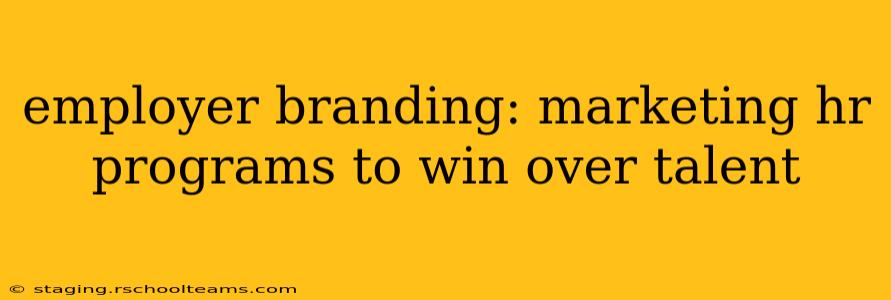In today's competitive job market, attracting and retaining top talent is paramount. Employer branding isn't just about creating a pretty logo; it's about crafting a compelling narrative that resonates with potential employees and showcases your company as an employer of choice. This involves strategically marketing your HR programs to highlight the unique value proposition you offer. This isn't just about throwing money at flashy ads; it's about authentically demonstrating your commitment to your employees' well-being and career growth.
What is Employer Branding?
Employer branding is the process of building a strong and positive reputation as an employer. It encompasses everything from your company culture and values to your employee benefits and compensation packages. It's about creating a consistent and compelling message that communicates what it's like to work for your organization and attracting candidates who align with your company's mission and values. Effectively marketing your HR programs is a crucial component of this process.
Marketing Your HR Programs: A Strategic Approach
Marketing your HR programs requires a multi-faceted approach, going beyond simply listing benefits on your careers page. It's about showcasing the experience of working for your company. This involves:
1. Defining Your Employer Value Proposition (EVP)
Before you start marketing, define your EVP. What makes your company a great place to work? What unique benefits and opportunities do you offer? This could be anything from competitive salaries and benefits to opportunities for professional development, flexible work arrangements, a strong company culture, or a commitment to social responsibility. Understanding your EVP is crucial for crafting targeted marketing messages.
2. Identifying Your Target Audience
Who are you trying to attract? Understanding the needs and aspirations of your ideal candidate is essential for crafting effective messaging. Consider factors such as age, experience, career goals, and values. Different demographics will respond to different marketing strategies.
3. Leveraging Multiple Channels
Don't rely on a single channel. Use a mix of strategies to reach your target audience:
- Social Media: Showcase your company culture, employee testimonials, and behind-the-scenes glimpses of daily life. Platforms like LinkedIn, Instagram, and even TikTok can be powerful tools.
- Your Website: Your careers page should be more than just a job board. Highlight your EVP, employee benefits, and company culture. Use compelling visuals and employee testimonials.
- Content Marketing: Create blog posts, articles, and videos that showcase your company culture and highlight your HR programs.
- Employee Referral Programs: Encourage current employees to refer their friends and family. This is a cost-effective way to attract high-quality candidates.
- Recruitment Events: Participate in career fairs and networking events to connect with potential candidates in person.
4. Show, Don't Just Tell
Authenticity is key. Instead of just listing benefits, show how those benefits translate into a positive employee experience. Use employee testimonials, case studies, and videos to demonstrate the impact of your HR programs.
5. Measuring Your Success
Track your key performance indicators (KPIs) to measure the effectiveness of your employer branding initiatives. This could include metrics such as application rates, time-to-hire, employee retention, and employee satisfaction.
Frequently Asked Questions (FAQ)
H2: How can I make my company's culture more attractive to potential employees?
Building an attractive company culture involves fostering a positive and inclusive work environment, promoting work-life balance, offering opportunities for professional development, and ensuring employees feel valued and appreciated. This requires actively listening to employee feedback, providing regular training and development opportunities, and celebrating successes.
H2: What are some creative ways to market my HR programs?
Consider using interactive content like quizzes or polls on social media to engage potential candidates. Develop short, compelling videos highlighting employee experiences. Host virtual or in-person events to showcase your company culture and benefits. Use employee-generated content (UGC) to build authenticity.
H2: How important are employee benefits in attracting talent?
Employee benefits are increasingly important in attracting and retaining top talent. Beyond the basics, consider offering unique benefits that cater to the specific needs and interests of your target audience. This might include flexible work arrangements, generous parental leave, wellness programs, or professional development stipends.
H2: How can I measure the ROI of my employer branding efforts?
Track metrics like application rates, cost-per-hire, employee retention rates, and employee Net Promoter Score (eNPS). Analyze your website traffic and social media engagement to understand the impact of your marketing efforts. Conduct employee surveys to gauge satisfaction levels.
By strategically marketing your HR programs and crafting a compelling employer brand, you can effectively attract and retain top talent, giving your organization a significant competitive advantage in today's challenging job market. Remember, it's about building a genuine connection with potential employees and showcasing the unique value proposition your company offers.
